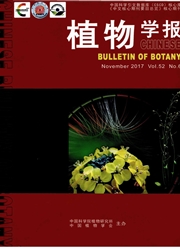

 中文摘要:
中文摘要:
蒺藜(Tribulus terrester)果实由5个集合繁殖体构成,是一种常见的具集合繁殖体的一年生植物。该文对不同月份成熟的蒺藜果实及果实集合繁殖体的形态、活力、吸水率、萌发率及萌发速率进行了比较观察,初步探讨其生态学意义。主要结果如下:1)果实各集合繁殖体间在质量、附属物质量百分比、种子数、活力、吸水率、萌发率及萌发速率方面随其发育顺序依次减小,存在显著差异;2)果实平均活力及萌发率随成熟时间依次升高,而吸水率依次降低,平均活力及萌发率与果实成熟时间正相关,而与吸水率负相关,成熟时间越早,活力及萌发率越低,吸水率越高;3)除9月最晚成熟的集合繁殖体在最适条件下均能萌发外,其余月份的果实各集合繁殖体只能部分萌发,且只有位于集合繁殖体长刺端的种子能萌发,这种在当季只萌发部分种子,剩下的种子仍然保持在一个扩散单元中并在数周、数月或数年间不规则地间隔萌发属于间歇性萌发。上述结果表明:不同月份成熟果实及果实不同发育顺序的集合繁殖体在形态、活力及吸水率方面存在梯度变化,这种变化可能是造成蒺藜间歇性萌发的主要原因,这种萌发对策可以降低同胞后代间的竞争,使其对可变环境中的生存风险进行有效的分摊,为物种的延续提供保障。
 英文摘要:
英文摘要:
Aims Tribulus terrester is an annual plant commonly found in the suburb of Urumqi, Xinjiang, China. One fruit of this species is composed of five synaptospermies. This study aims to explore the morphological traits and intermittent germination characteristics of synaptospermy and further investigate the adaptability of its seeds under changing enviroment. Methods Shape, color and appendage of synaptospermy, and the mass, length of burs, percentage of appendage mass, number of seeds per synaptospermy, were determined; and the vigor, water absorption and germination characteristics of synaptospermies matured at different month were compared in the laboratory. Important findings The synaptospermies became hardened after ripening, with scale-form appendages, and they are significantly different in mass, the percentage of mass of appendage, amount of seeds, vigor, water absorption rate, germination percentage and germination rate. The averages of vigor and germination percentage were in-creasing and the water absorption rate was decreasing following the order of maturing month in July, August and September. The average of vigor was positively correlated with the ripening time of fruit, as well as germination percentage, while the water absorption rate was negatively correlated with the ripening time of fruit. This suggests that the earlier the fruit ripening, the lower the vigor and germination rate and the higher the water absorption rate. Under the best germination conditions, all synaptospermies matured in September could germinate, whereas only some synaptospermies could germinate if matured in the other two months. Moreover, only those seeds located in the position of the long thorn of one synaptospermy could germinate. Part of the seeds could germinate in the season of ripening;the others retain in the dispersal unit and germinate after several weeks, months or years. This germination behavior was defined as intermittent germination. These results indicate that there is a change of gradient in morph
 同期刊论文项目
同期刊论文项目
 同项目期刊论文
同项目期刊论文
 期刊信息
期刊信息
